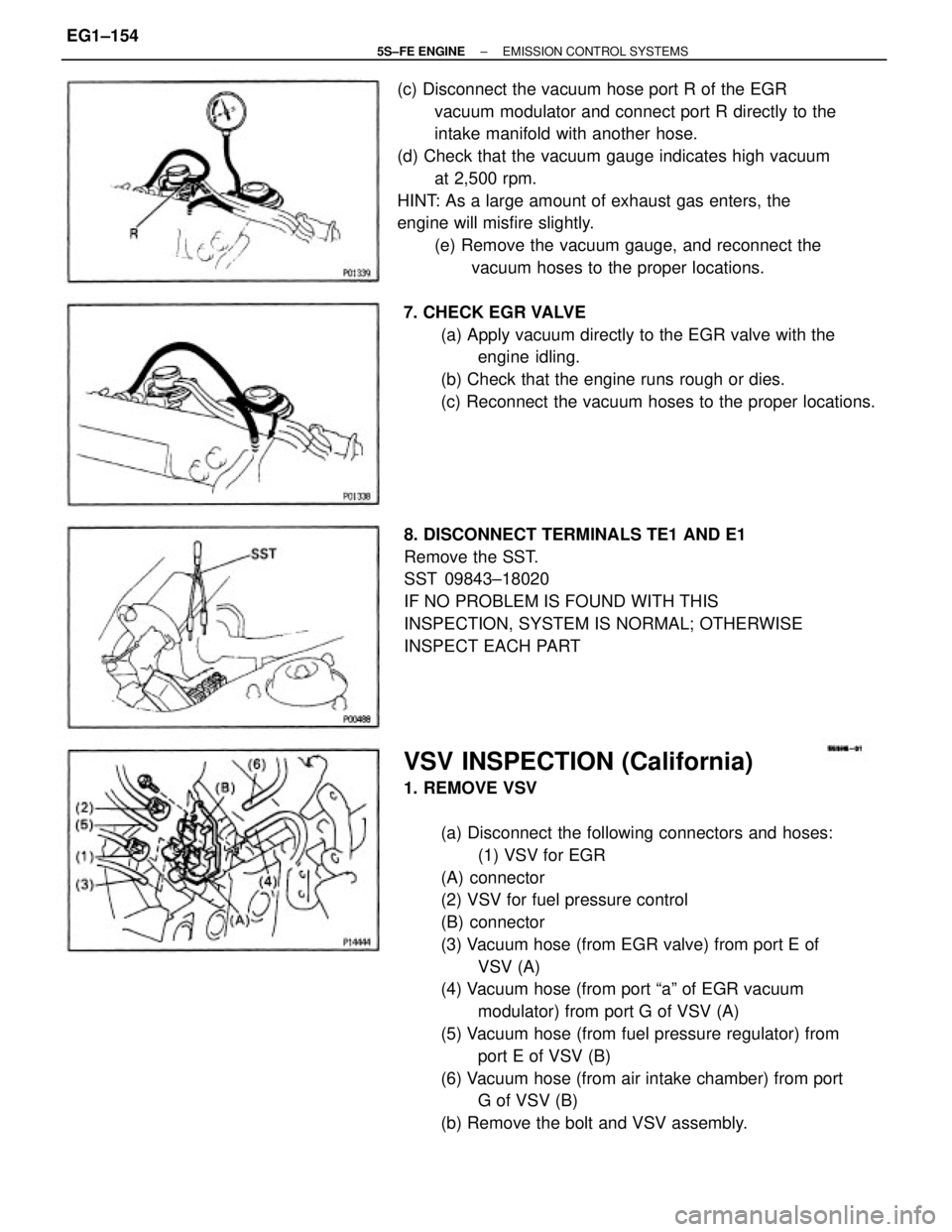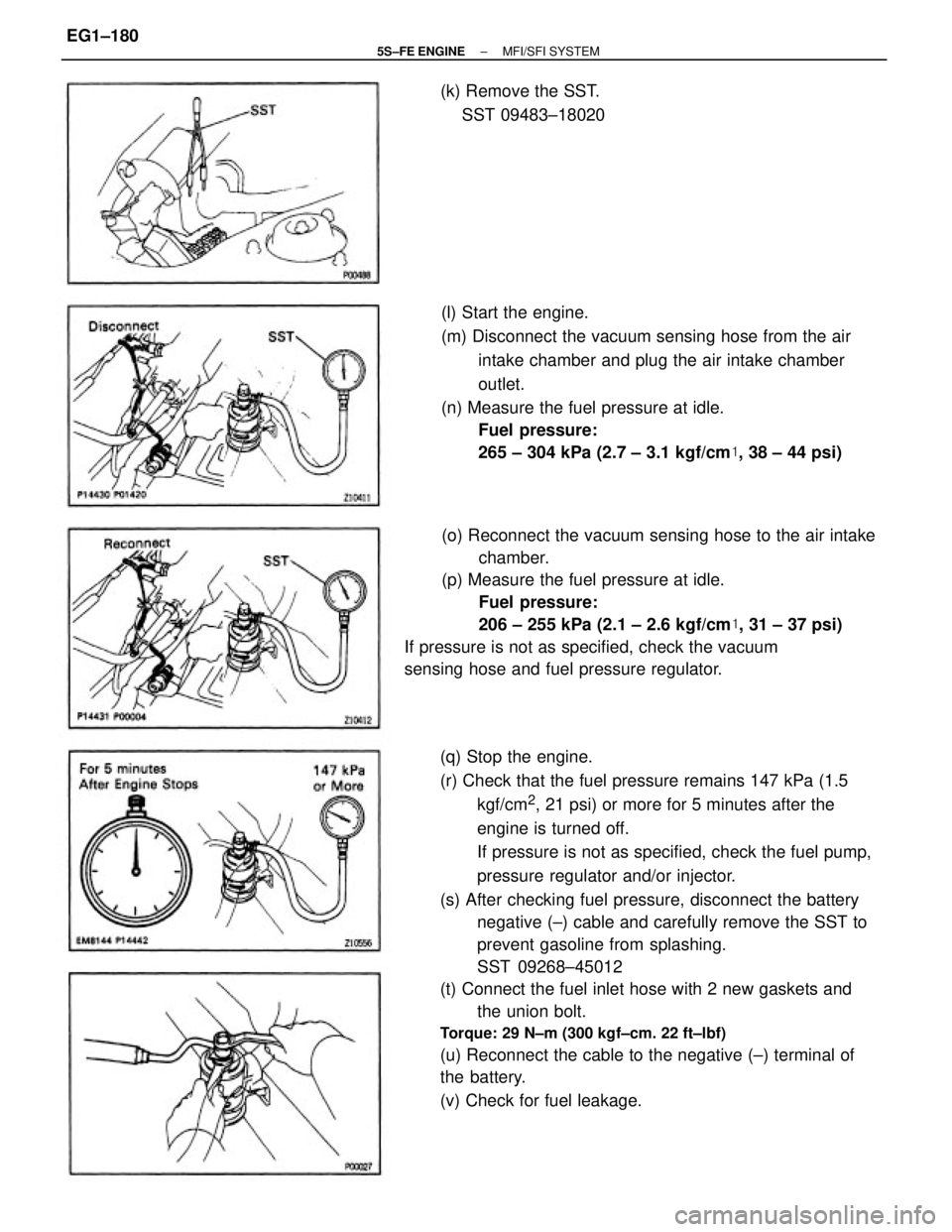Page 203 of 4770
EGR SYSTEM INSPECTION
1. CHECK AND CLEAN FILTER IN EGR VACUUM
MODULATOR
(a) Check the filter for contamination or damage.
(b) Using compressed air, clean the filter.
HINT: Install the filter with the coarser surface facing
the atmospheric side (outward).
2. PREPARATION
Using a 3±way connector, connect a vacuum gauge
to the hose between the EGR valve and VSV.
3. CHECK SEATING OF EGR VALVE
Start the engine and check that the engine starts and
runs at idle.
6. CHECK VSV AND EGR VACUUM MODULATOR
WITH HOT ENGINE
(a) Warm up the engine.
(b) Check that the vacuum gauge indicates low vacuum
at 2,500 rpm. 5. CHECK VSV
(a) The engine coolant temperature should be below
60�C (140�F) (A/T) or 55�C (131 �F) (M/T).
(b) Check that the vacuum gauge indicates zero at 2.500
rpm. 4. CONNECT TERMINALS TE1 AND E1
Using SST, connect terminals TE 1 and E 1 of the data
link connector 1.
SST 09843±18020
± 5S±FE ENGINEEMISSION CONTROL SYSTEMSEG1±153
Page 204 of 4770

VSV INSPECTION (California)
1. REMOVE VSV
(a) Disconnect the following connectors and hoses:
(1) VSV for EGR
(A) connector
(2) VSV for fuel pressure control
(B) connector
(3) Vacuum hose (from EGR valve) from port E of
VSV (A)
(4) Vacuum hose (from port ªaº of EGR vacuum
modulator) from port G of VSV (A)
(5) Vacuum hose (from fuel pressure regulator) from
port E of VSV (B)
(6) Vacuum hose (from air intake chamber) from port
G of VSV (B)
(b) Remove the bolt and VSV assembly. (c) Disconnect the vacuum hose port R of the EGR
vacuum modulator and connect port R directly to the
intake manifold with another hose.
(d) Check that the vacuum gauge indicates high vacuum
at 2,500 rpm.
HINT: As a large amount of exhaust gas enters, the
engine will misfire slightly.
(e) Remove the vacuum gauge, and reconnect the
vacuum hoses to the proper locations.
8. DISCONNECT TERMINALS TE1 AND E1
Remove the SST.
SST 09843±18020
IF NO PROBLEM IS FOUND WITH THIS
INSPECTION, SYSTEM IS NORMAL; OTHERWISE
INSPECT EACH PART 7. CHECK EGR VALVE
(a) Apply vacuum directly to the EGR valve with the
engine idling.
(b) Check that the engine runs rough or dies.
(c) Reconnect the vacuum hoses to the proper locations.
± 5S±FE ENGINEEMISSION CONTROL SYSTEMSEG1±154
Page 205 of 4770
VSV INSPECTION (Except California)
1. REMOVE VSV
(a) Disconnect the following connector and hoses:
(1) VSV connector
(2) Vacuum hose (from EGR valve) from port E of
VSV
(3) Vacuum hose (from port ªQº of EGR vacuum
modulator) from port G of VSV 2. INSPECT VSV
A. Inspect VSV for open circuit
Using an ohmmeter, check that there is continuity
between the terminals.
Resistance (Cold):
33±39�
If there is no continuity, replace the VSV.
B. Inspect VSV for ground
Using an ohmmeter, check that there is no continuity
between each terminal and the body.
If there is continuity, replace the VSV.
(b) Apply battery voltage across the terminals.
(c) Check that air flows from port E to the filter.
If operation is not as specified, replace the VSV.
3. REINSTALL VSVC. Inspect VSV operation
(a) Check that air flows from port E to port G.
± 5S±FE ENGINEEMISSION CONTROL SYSTEMSEG1±155
Page 207 of 4770
EGR VALVE INSPECTION
1. REMOVE EGR VALVE
Check for sticking and heavy carbon deposits.
If a problem is found, replace the valve.
2. REINSTALL EGR VALVE WITH NEW GASKET
Nut
Torque: 13 N±m (130 kgf±cm, 9 ft±lbf)
Union nut
Torque: 59 N±m (600 kgf±cm, 43 ft±lbf)
EGR VACUUM MODULATOR INSPECTION
CHECK EGR VACUUM MODULATOR OPERATION
(a) Disconnect the vacuum hoses from ports P, Q and R
of the EGR vacuum modulator.
(b) Block ports P and R with your finger.
(c) Blow air into port Q, and check that the air passes
through to the air filter side freely.
(d) Start the engine, and maintain speed at 2.500 rpm.
(e) Repeat the above test. Check that there is a strong
resistance to air flow.
(f) Reconnect the vacuum hoses to the proper locations.
± 5S±FE ENGINEEMISSION CONTROL SYSTEMSEG1±157
Page 220 of 4770
PREPARATION
SST (SPECIAL SERVICE TOOLS)
(90405±09015) No.1 Union (09268±41090) No.7 union (09268±41080) No.6 union
09631±22020 Power Steering Hose Nut
14 x 17 mm Wrench Set
RECOMMENDED TOOLS
Plug for vacuum hose, fuel hose
etc. 09268±41045 Injection Measuring Tool Set
09082±00050 TOYOTA Electrical Tester Set 09842±30070 Wiring ªFº EFI Inspection 09268±45012 EFI Fuel Pressure Gauge
09843±18020 Diagnosis Check Wire
09200±00010 Engine Adjust Kit
09258±00030 Hose Plug SetFuel line flare nut
± 5S±FE ENGINEMFI/SFI SYSTEMEG1±170
Page 230 of 4770

(q) Stop the engine.
(r) Check that the fuel pressure remains 147 kPa (1.5
kgf/cm
2, 21 psi) or more for 5 minutes after the
engine is turned off.
If pressure is not as specified, check the fuel pump,
pressure regulator and/or injector.
(s) After checking fuel pressure, disconnect the battery
negative (±) cable and carefully remove the SST to
prevent gasoline from splashing.
SST 09268±45012
(t) Connect the fuel inlet hose with 2 new gaskets and
the union bolt.
Torque: 29 N±m (300 kgf±cm. 22 ft±lbf)
(u) Reconnect the cable to the negative (±) terminal of
the battery.
(v) Check for fuel leakage.(o) Reconnect the vacuum sensing hose to the air intake
chamber.
(p) Measure the fuel pressure at idle.
Fuel pressure:
206 ± 255 kPa (2.1 ± 2.6 kgf/cm�, 31 ± 37 psi)
If pressure is not as specified, check the vacuum
sensing hose and fuel pressure regulator.(l) Start the engine.
(m) Disconnect the vacuum sensing hose from the air
intake chamber and plug the air intake chamber
outlet.
(n) Measure the fuel pressure at idle.
Fuel pressure:
265 ± 304 kPa (2.7 ± 3.1 kgf/cm�, 38 ± 44 psi) (k) Remove the SST.
SST 09483±18020
± 5S±FE ENGINEMFI/SFI SYSTEMEG1±180
Page 237 of 4770
2. DISCONNECT FUEL RETURN PIPE FROM FUEL
PRESSURE REGULATOR
(a) Put a suitable container or shop rag under the pres±
sure regulator.
(b) Remove the union bolt and 2 gaskets, and disconnect
the return pipe from the pressure regulator.
HINT: Slowly loosen the union bolt.
FUEL PRESSURE REGULATOR
ON±VEHICLE INSPECTION
INSPECT FUEL PRESSURE
(See page EG1±178)
COMPONENTS FOR REMOVAL AND
INSTALLATION
FUEL PRESSURE REGULATOR REMOVAL
1. DISCONNECT VACUUM SENSING HOSE FROM
FUEL PRESSURE REGULATOR
± 5S±FE ENGINEMFI/SFI SYSTEMEG1±187
Page 238 of 4770
FUEL PRESSURE REGULATOR
INSTALLATION
(See Components for Removal and Installation)
1. INSTALL FUEL PRESSURE REGULATOR
(a) Apply a light coat of gasoline to a new O±ring, and
install it to the pressure regulator.
2. CONNECT FUEL RETURN PIPE TO FUEL PRESSURE
REGULATOR
Install the return pipe with 2 new gaskets and the
union bolt.
Torque: 19 N±m (195 kgf±cm, 14 ft±lbf)
3. REMOVE FUEL PRESSURE REGULATOR
(a) Remove the 2 bolts, and pull out the pressure regula±
tor.
(b) Remove the O±ring from the pressure regulator.
3. CONNECT VACUUM SENSING HOSE TO FUEL
PRESSURE REGULATOR
4. CHECK FOR FUEL LEAKAGE
(See page EG1±176) (b) Install the pressure regulator with the 2 bolts.
Torque: 5.4 N±m (55 kgf±cm, 48 in.±lbf)
± 5S±FE ENGINEMFI/SFI SYSTEMEG1±188